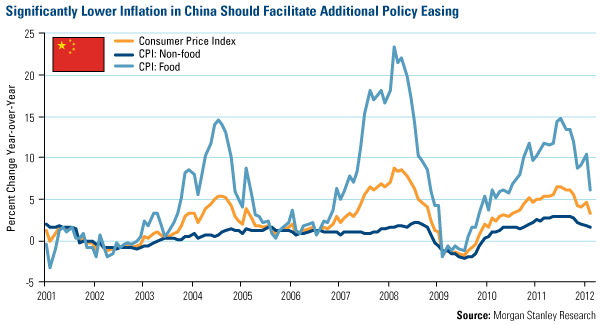Emerging Markets Radar (March 12, 2012)
Strengths
- The Global Emerging Markets Fund (GEMFX) has benefited from a bias toward small-caps in 2012. On a relative basis, the fund has benefited from choosing stocks that pay more than twice the dividend yield of the Russell 2000 Index and those companies which have a low price-to-earnings ratio.
- China’s February Consumer Price Index (CPI) was up 3.2 percent in February, lower than the estimate of 3.5 percent and below January’s 4.5 percent figure. With inflation expectations tamed, the market expects the People’s Bank of China (PBOC) to further cut the reserve requirement ratio (RRR).
- China’s fixed asset investment (FAI) growth came in stronger than expected at 21.5 percent year-over-year during the first two months of 2012, up from 18 percent in December. Interestingly, residential FAI rose 27 percent, the same pace as last year. This indicates that the housing market may not collapse as many worried last year.
- New bank deposits rebounded strongly in February to Rmb 1.6 trillion, enabling Chinese banks to lend more in March. In addition, M2 money supply growth was near expectations, right at 13 percent.
- Philippine CPI rose 2 percent in February. This is well below the 3.2 percent increase that was forecasted.
Weaknesses
- China’s retail sales and industrial production growth came in weaker than expected. Retail sales rose 14.7 percent, down from 17.1 percent in 2011. Industrial production rose 11.4 percent, slowing by 1.4 percentage points from December. These data points indicate that China had probably over tightened its monetary and industrial policies and needs to loosen up these policies during the first half of the year.
- China has lowered the country’s GDP growth target to 7.5 percent this year, 50 basis points lower than in the past eight years. Many believe Chinese policymakers will try to slow down the country’s economic growth by curbing housing market growth and postponing some infrastructure growth. However, China has consistently beaten its own GDP target every year over the last decade and the country will still encourage growth in consumption and industrial enhancement.
- Malaysia’s exports grew 0.4 percent in January, the slowest pace in 15 months.
- After a good run, Turkish industrial production faltered in January. Industrial production was up by 1.5 percent year-over-year in January, weaker than the market expectations. Turkey’s Purchasing Manager’s Index (PMI) also deteriorated in February as a result of poor weather conditions.
Opportunities
- Droughts from Mexico to Argentina are shrinking corn stockpiles to a five-year low. This raises the prospect of a bull market in the U.S., as farmers are expecting to see the biggest crop ever.
- Corn demand in China, the biggest consumer after the U.S., may decline after Premier Wen Jiabao lowered the annual growth target to 7.5 percent. Prices fell 16 percent in the last four months of 2011 as the U.S. Department of Agriculture (USDA) predicted Brazil and Argentina would produce their biggest crops ever. The two countries currently account for almost 10 percent of global corn supply. While prices may keep rising for now, analysts anticipate declines by the end of the year as U.S. growers harvest the most acres planted since 1944.
- This chart shows China’s inflation has come down notably since July 2011. Food prices, the largest contributor to the rise in inflation last year, have come down since the fourth quarter after the supply chain and logistics were improved. The market expects the PBOC to cut RRR again in order to support economic growth and liquidity in the economy.

Threats
- While investment flows pour into most of the largest emerging markets, foreign investors are selling South African equities at the fastest pace in four years over growing concern that policy makers will seek a larger share of the nation’s mining profits. International investors sold $933 million of South African equities in the first two months of this year and are on track for the biggest first-quarter outflow since 2008.
- A study commissioned by President Jacob Zuma’s ruling African National Congress party proposed increasing taxes on the mining industry last month. In addition, the party’s youth wing has lobbied for a government takeover of gold and platinum mines to boost employment in Africa’s biggest economy.
- China’s February retail sales rose 14.7 percent, below the expectations of policymakers. In order to reach the stated consumption growth target near or above 18 percent, Chinese policymakers need to loosen the country’s monetary policy or begin a fiscal subsidy, such as a new home appliance incentive.












